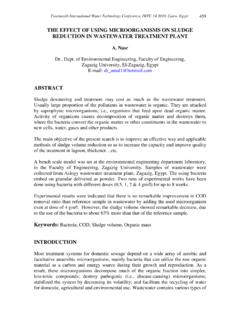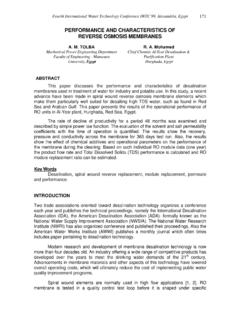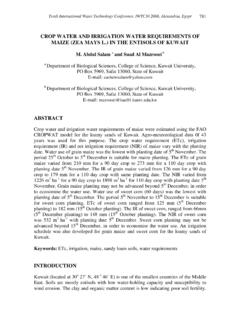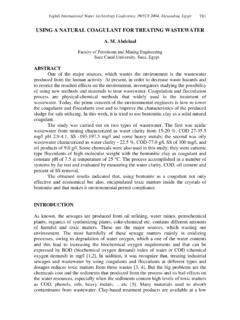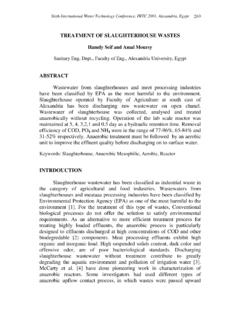Transcription of REMOVAL OF AMMONIA AND PHENOL FROM …
1 Eleventh International water Technology Conference, IWTC11 2007 Sharm El-Sheikh, Egypt 949 REMOVAL OF AMMONIA AND PHENOL FROM industrial waste water Alaa Eldean Kabbarry Ramadan Master of Occupational Health Assistant General Manager of Environmental Sector, Middle East Operation & Maintenance Co. (MIDOM), Egypt E-mail: ABSTRACT The activated sludge process is a wastewater treatment method in which the carbonaceous organic matter of wastewater provides an energy source for the microorganisms.
2 The microbes convert carbon into cell tissue and oxidized end products that include production of new cells for a mixed population of microorganisms in an aquatic aerobic environment carbon dioxide and water . In addition, a limited number of microorganisms may exist in activated sludge that obtains energy by oxidizing AMMONIA nitrogen to nitrate nitrogen in the process known as nitrification. The beneficial role of nitrifying bacteria within saltwater and freshwater aquaria environments is their function in the nitrogen cycle, which involves the conversion of AMMONIA to nitrite and the subsequent conversion of nitrite to nitrate.
3 During the process of nitrification, nitrifying bacteria detoxify AMMONIA in two steps. First, Nitrosamines spp. converts toxic AMMONIA to nitrite, which is also toxic to fish. Then in the second step, nitrite is converted to nitrate by the Nitrobacter spp. Nitrate is not considered toxic unless it accumulates in high concentrations. There are numerous commercial products claiming to contain nitrifying bacteria that will facilitate the conversion of toxic AMMONIA to non-toxic nitrate within aquaria.
4 In this paper we discussed the factors affecting on the growth of nitrifying bacteria and the best conditions to reduce (over 85% of AMMONIA , over 90% of PHENOL and over 80% of BOD) in biological step in waste water treatment plant for industrial waste water . INTRODUCTION The beneficial role of nitrifying bacteria within saltwater and freshwater aquaria environments is their function in the nitrogen cycle, which involves the conversion of AMMONIA to nitrite and the subsequent conversion of nitrite to nitrate.
5 During the process of nitrification, nitrifying bacteria detoxify AMMONIA in two steps. First, Eleventh International water Technology Conference, IWTC11 2007 Sharm El-Sheikh, Egypt 950 Nitrosomonas spp. converts toxic AMMONIA to nitrite. Then in the second step, nitrite is converted to nitrate by the Nitrobacter spp. Nitrate is not considered toxic unless it accumulates in high concentrations. There are numerous commercial products claiming to contain nitrifying bacteria that will facilitate the conversion of toxic AMMONIA to non-toxic nitrate within aquaria.
6 This study was undertaken to investigate the efficacy of both nitrification and de-nitrification Efficacy was determined by measuring the conversion of AMMONIA and nitrate for nitrification and by measuring the reduction of BOD and PHENOL for de-nitrification. Studies in our laboratory have indicated that the factors affecting on nitrification and de-nitrification processes. BIOLOGICAL TREATMENT The biological treatment consists of two steps nitrification and de-nitrification in the most plants the first step is nitrification and the second step is the de-nitrification but in our plant the first step is de-nitrification and the second step is the nitrification.
7 One study demonstrated that a C: N ration of at least 3:1 was necessary after nitrification to promote de-nitrification. At lower C: N ratios, the rate of de-nitrification decreased rapidly. One preferred method to avert the problem of effluent degradation is to place the de-nitrification basin before the aerobic reactor basin (in which carbonaceous REMOVAL and nitrification are taking place) and recycle a high volume of the flow from the nitrification reactor basin back to the de-nitrification basin Raw wastewater also has been used as the source of organic carbon to effect de-nitrification.
8 However, this procedure may adversely affect effluent quality by causing increases in BOD5 and AMMONIA . BIOLOGICAL FLOCCULATION One of the factors essential to the performances of the activated sludge process is effective flocculation of the sludge, with subsequent rapid settling and compaction of the floc, it has been shown that flocculation results from the production of a sticky polysaccharide slime lager to which organism adhere. Flagellates are also entrapped in this slimy material.
9 The slime formation does not occur during the long-growth phase and required excess available carbohydrate. Effective flocculation therefore requires a relatively low food-to microorganism s ratio (declining growth and high sludge age) and excess available carbohydrate. Flocculation it self will not ensure rapid settling. Conditions in the process must be maintained to promote a high-density sludge. Eleventh International water Technology Conference, IWTC11 2007 Sharm El-Sheikh, Egypt 951 In general, the maintenance of aerobic conditions with an available carbon source stimulates the growth of fungi and other filamentous forms, resulting in so-called bulking sludge.
10 Okun indicated that Spherotilus are aerobic and require oxygen and an available carbon source but may suffer in the competition for food in highly aerobic environment. Because of their high surface area/volume ratio, the filamentous organisms may survive better under low oxygen tensions than other flocculated aerobic growth. Failure to maintain oxygen in the aeration system can result in diffuse non settling floes because of the high for production under anaerobic conditions.
